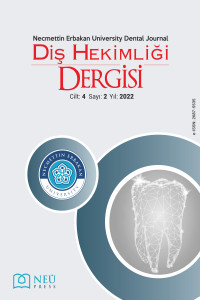Stafne Kemik Kavitesi: Vaka Serisi
korpus, mandibula, ramus, Stafne kemik kavitesi
Stafne Bone Cavity: Case Series
corpus, mandible, ramus, Stafne bone cavity,
___
- 1. Stafne EC. Bone cavities situated near the angle of the mandible. J Am Dent Assoc. 1942;29:1969-72.
- 2. Kaya M, Ugur KS, Dagli E, Kurtaran H, Gunduz M. Stafne bone cavity containing ectopic parotid gland. Braz J Otorhinolaryngol. 2018;84:669-72.
- 3. Assaf AT, Solaty M, Zrnc TA, et al. Prevalence of Stafne's bone cavity–retrospective analysis of 14,005 panoramic views. In vivo. 2014;28:1159-64.
- 4. Philipsen H, Takata T, Reichart P, Sato S, Suei Y. Lingual and buccal mandibular bone depressions: a review based on 583 cases from a world-wide literature survey, including 69 new cases from Japan. Dentomaxillofac Radiol. 2002;31:281-90.
- 5. Quesada Gómez C, Valmaseda Castellón E, Berini Aytés L, Gay Escoda C. Stafne bone cavity: a retrospective study of 11 cases. Med Oral Patol Oral Cir Bucal. 2006;11:277-80.
- 6. Lee KH, Thiruchelvam J, McDermott P. An unusual presentation of Stafne bone cyst. J Maxillofac Surg. 2015;14:841-44.
- 7. Etöz M, Etöz O, Şahman H, Şekerci A, Polat H. An unusual case of multilocular Stafne bone cavity. Dentomaxillofac Radiol. 2012;41:75-8.
- 8. de Courten A, Küffer R, Samson J, Lombardi T. Anterior lingual mandibular salivary gland defect (Stafne defect) presenting as a residual cyst. Oral Surg Oral Med Oral Radiol. 2002;94:460-4.
- 9. Probst FA, Probst M, Maistreli I-Z, Otto S, Troeltzsch M. Imaging characteristics of a Stafne bone cavity—panoramic radiography, computed tomography and magnetic resonance imaging. Oral Maxillofac Surg. 2014;18:351-3.
- 10. Bereket M, Şenel E, Şener İ. Yağ dokusu İçeren nadir bir stafne kemik kavitesi olgusu. Cumhuriyet Dent J. 2012;15:249-54.
- 11. Prechtl C, Stockmann P, Neukam FW, Schlegel KA. Enlargement of a Stafne cyst as an indication for surgical treatment–a case report. J Craniomaxillofac Surg. 2013;41:270-3.
- 12. Mauprivez C, Amor MS, Khonsari RH. Magnetic resonance sialography of bilateral Stafne bone cavities. J Maxillofac Surg. 2015;73:934.
- 13. Branstetter BF, Weissman JL, Kaplan SB. Imaging of a Stafne bone cavity: what MR adds and why a new name is needed. Am J Neuroradiol. 1999;20:587-9.
- 14. Arya S, Pilania A, Kumar J. Prevalence of Stafne's Cyst–A retrospective analysis of 18,040 Orthopantomographs in Western India. J Indian Acad Oral Med Radiol. 2019;31:40.
- 15. Venkatesh E. Stafne bone cavity and cone-beam computed tomography: a report of two cases. J Korean Assoc Oral Maxillofac Surg. 2015;41:145.
- 16. Demiralp KÖ, Bayrak S, Çakmak ESK. Assessment of Stafne bone defects prevalence and characteristics by using cone beam computed tomography: a retrospective study. Kırıkkale Uni Med J. 2017;19:167-72.
- 17. Akbaş M, Akbulut MB. Seçilmiş bir Genç Türk Popülasyonunun Molar Dişlerinde Apikal Periodontitis Prevalansı ve Kanal Tedavisi Kalitesinin Değerlendirilmesi. NEU Dent J. 2020; 2: 52-8.
- 18. Yılmaztürk SS, Yarbaşı Ö, Bozdemir E. Bir Diş Hekimliği Fakültesine Başvuran Hastaların Radyasyonun Zararları ve Biyolojik Etkileri Hakkındaki Bilgi Düzeylerinin Değerlendirilmesi. NEU Dent J. 2020;2:1-8.
- 19. Ergüven Samur S, Çizmeci Şenel F. Stafne kemik kavitesi: İki olgu sunumu. Med J Ankara Tr Res Hosp. 2017; 50: 46-9.
- 20. More CB, Das S, Gupta S, Patel P, Saha N. Stafne’s bone cavity: a diagnostic challenge. J Clin Diagnostic Res. 2015;9:16.
- 21. Dereci Ö, Duran S. Intraorally exposed anterior Stafne bone defect: a case report. J Oral Med Oral Surg Oral Pathol Oral Radiol. 2012;113:e1-3.
- 22. Flores Campos PS, Oliveira JAC, Dantas JA, et al. Stafne's defect with buccal cortical expansion: a case report. Int J Dent. 2010.
- 23. Aguiar LBV, Neves FS, Bastos LC, Crusoé-Rebello I, Ambrosano GMB, Campos PSF. Multiple stafne bone defects: a rare entity. Int Sch Res. 2011.
- 24. Mann RW. Three‐dimensional representations of lingual cortical defects (Stafne's) using silicone impressions. J Oral Pathol Med. 1992;21:381-4.
- 25. Herranz-Aparicio J, Figueiredo R, Gay-Escoda C. Stafne’s bone cavity: an unusual case with involvement of the buccal and lingual mandibular plates. Int J Exp Dent Sci. 2014;6:e96.
- 26. Kao Y-H, Huang I-YE, Chen C-M, Wu C-W, Hsu K-J, Chen C-M. Late mandibular fracture after lower third molar extraction in a patient with Stafne bone cavity: a case report. J Maxillofac Surg. 2010;68:1698-700.
- Yayın Aralığı: Yılda 3 Sayı
- Başlangıç: 2019
- Yayıncı: Necmettin Erbakan Üniversitesi
Endodontik Tıp: Apikal Periodontitis Kardiyovasküler Hastalıklara Predispozan Etken Olabilir mi?
Eray CEYLANOĞLU, Dilek HANÇERLİOĞULLARI
Mehmet Gökberkkaan DEMİREL, Ali Riza TUNCDEMİR
Büşra BOSTANCI, Yasemin Derya FİDANCIOĞLU
Ankaferd Kanama Durdurucunun Donör Bölgede Yara İyileşmesi Üzerine Etkisinin İncelenmesi
Ahmet Cemil TALMAÇ, Dicle ALTINDAL, Metin ÇALIŞIR, Bilal EGE
Arif Yiğit GÜLER, Sevde GÖKSEL
Stafne Kemik Kavitesi: Vaka Serisi
Büşra ÖZTÜRK, Taha ZİREK, Ali ALTINDAĞ, Melek TASSOKER
Tiktok'taki Ortognatik Cerrahi Videolarının Güvenilirliği ve Kalitesi: Kesitsel Bir Çalışma
Invers Dişlerin Radyolojik Açıdan Değerlendirilmesi
